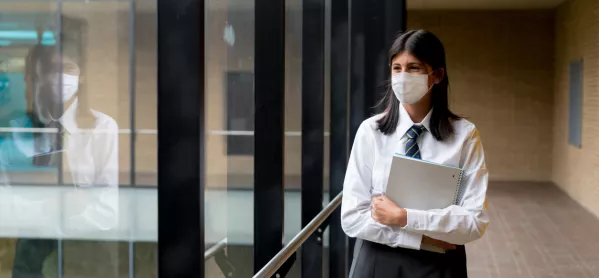Masks to be worn ‘at all times’ in Scottish secondaries

Face coverings are to be worn “at all times” after the Easter break by students and staff in Scottish secondaries, according to Scottish government guidance on the return to school.
However, the public health and education experts advising the Scottish government have rejected a call from teaching unions for staff and students to be required to wear medical-grade masks in secondaries.
The guidance says: “The [Advisory Sub-group on Education and Children’s Issues’] view was that such a requirement was not commensurate with the risk in school settings, and that cloth face coverings, when combined with the other, more important, mitigations of physical distancing and hand hygiene, were considered appropriate in schools.”
The guidance adds that the “additional measure” of requiring face coverings to be worn at all times by staff and students in secondary schools was agreed “including S1-S3 learners (not just the senior phase) in classrooms, in communal areas and when moving about the school”.
Covid: How effective could face masks be in classrooms?
Watch: Why deaf students struggle with face coverings
Teacher’s take: What it’s like having to teach with a face covering
England: Masks still required in secondary school classrooms next term
The guidance says that face coverings should be “made of cloth or other textiles and should be two, and preferably three, layers thick and fit snugly while allowing you to breathe easily”. It also provides a link to a Scottish government video on “how to make a simple face covering”.
Covid: Government rejects request for medical-grade face masks in schools
However, in special schools, the guidance warns, “opaque face coverings may act as a barrier to communication”. It says the impact of wearing a face mask for very young learners or pupils with additional support needs “should be carefully considered”, given that “communication for many of these learners (including hearing-impaired young people) relies in part on being able to see someone’s face clearly”.
It says transparent masks may assist communication where someone relies on “lip reading, clear sound or facial expressions to communicate”.
The guidance states that face coverings should also be worn in the following circumstances (except where an adult or child/young person is exempt from wearing a covering):
- At all times when adults in primary schools are moving around the school in corridors, office and admin areas, canteens (except when dining) and other confined communal areas, (including staff rooms and toilets).
- At all times for all staff and learners in secondary schools (including special schools and independent and grant-aided schools).
- In line with the current arrangements for public transport, where adults and children and young people aged 5 and over are travelling on dedicated school transport
First minister Nicola Sturgeon confirmed yesterday that Scottish secondaries would be returning full-time after the holidays - all primary pupils returned to the classroom full-time in March.
She said the return to secondary full-time would involve “the removal where necessary of strict two-metre physical distancing between pupils”.
In the wake of the announcement, the EIS teaching union expressed its frustration that its call for the provision of medical-grade face masks for staff had been rejected.
It also said that more progress was needed on “monitoring and improving ventilation”, saying some councils had “dragged their heels”.
EIS general secretary Larry Flanagan said: “If we had made more progress on the EIS demands of ventilation, vaccination and face masks, we would be in a stronger position. Improving such mitigations is still possible.”
He added that teachers would be “keen to engage positively with pupils to support their wellbeing and their progress in learning” but said that would be “a particular challenge for senior pupils as lockdown has squeezed the time available for the alternative certification model”.
You need a Tes subscription to read this article
Subscribe now to read this article and get other subscriber-only content:
- Unlimited access to all Tes magazine content
- Exclusive subscriber-only stories
- Award-winning email newsletters
Already a subscriber? Log in
You need a subscription to read this article
Subscribe now to read this article and get other subscriber-only content, including:
- Unlimited access to all Tes magazine content
- Exclusive subscriber-only stories
- Award-winning email newsletters



